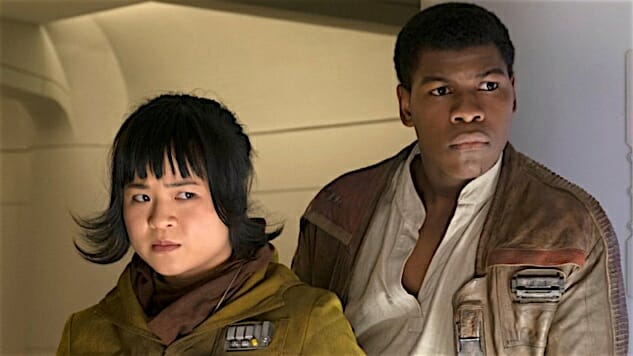A Star Wars Author on the Intolerance within the Fandom
“Take a deep breath and remember that you love Star Wars.”

On balance, being a Star Wars fan has lately been somewhat more exhausting than parenting my girlfriend’s four kids. It’s easy to forget that, what with this new, glitzy age of competently directed blockbusters courtesy of Disney’s stewardship of the franchise, but you never have to wait long for a reminder. Consider this past month’s news that Kelly Marie Tran—the actor who portrays newcomer Rose Tico in The Last Jedi—has deleted her Instagram posts in the wake of vile comments on them. As of this writing, Tran hasn’t issued a statement, but we’re talking about her interactions with the same fandom who has driven Daisy Ridley off Instagram in similar fashion and which tormented Jake Lloyd, the guy who portrayed a young Anakin Skywalker in The Phantom Menace and who, I should point out, basically just did what his directors told him to do.
There is a growing—in intensity if not in actual numbers—wrongheaded and inexplicable part of the fandom’s very worst members, all of whom seem to be aggrieved at the very idea that this sandbox of space wizards and mechanically unrealistic starcraft is now being infiltrated by girls and minorities. It’s something Kevin J. Anderson—author of books that basically continued the Star Wars story between the original trilogy and the movies’ return in 1999 and beyond—has wrestled with.
“The first time I saw the shocking troglodyte fan reaction—with racism, sexism, and intolerance—was in the (minority) flood of reaction against The Last Jedi,” Anderson says. “I couldn’t believe the open hatred, which continued with the Solo movie.”
And before anybody starts agitating about the works of Anderson or his contemporaries being a part of the discontinued “Legends” canon, please take a seat. We’re talking about the Star Wars mythos and fandom, the shared conception all fans have had since 1977. All that stuff is part of the phenomenon, just like Adam West is part of Batman and Christopher Reeves is part of Superman, despite anything Warner Bros. may currently be rebooting.
Star Wars, the original three-film phenomenon of the late ’70s and early ’80s, was a straightforward story of good vs. evil. A lot of the deeper meaning behind it has been read into it during the intervening years and then added to by dozens of other creators—like Anderson—who have been handed some corner of the Galaxy Far, Far Away to fill in with their own dreams. So let’s look at what they had to work with and how they’ve built upon it.
The First First Order
Star Wars is rooted, inextricably grounded, in a post-World War II sensibility. It knows who its bad guys are and who its good guys are, even if it’s too focused on the lineage of its main characters or the loving shots of its bombing runs to stare too closely at everybody’s respective ideologies. It doesn’t have to because you know and I know what they are: The Empire represents brutal fascist heavy-handedness and all the callous violence that implies, and the Rebellion represents freedom and justice and openness for all peoples. There was not a single woman or minority (human or alien) among the arrogant officers or dull and disinterested stormtroopers of the Empire in the original films, but the Rebellion was happy to have them. And why should this not have been the position of a good vs. evil action adventure film conceived by a man born in 1944?
“The Rebellion seemed to be much more full of non-white, non-male, non-human characters, while the Empire was a bunch of white guys,” Anderson says. “The Rebellion is pretty obvious as an open-minded government against the racism/sexism/despotism of the Empire. The new films are very clear in their portrayal of the new order as very white, very intolerant.”
When Timothy Zahn was tasked with writing his landmark Star Wars novel trilogy that began with Heir to the Empire in 1991, he created the Grand Admiral Thrawn character—an alien from a species called the Chiss and a tactical genius who emerged to menace the fledgling New Republic that had arisen in the five years since the Rebellion’s triumph over the Empire in Return of the Jedi. He is perhaps one of the most enduring characters of the Expanded Universe—so beloved by fans that he’s been brought back into the official canon by appearing as a chief antagonist in the Star Wars: Rebels cartoon (which I don’t like all that much but whose creators I haven’t harassed or threatened).
Aside from being a theatrical and menacing villain, he also hammered home an important point about the Empire. Characters in Zahn’s trilogy of novels remark upon the fact Thrawn must be an exceptional tactician indeed to have risen in the ranks of the Empire because Emperor Palpatine was a known xenophobe who ran a government and a military predicated on racial purity. Where on Earth could Anderson and Zahn and their contemporaries have gotten such notions?
-

-

-

-

-

-

-

-

-

-

-

-

-

-

-

-

-

-

-

-

-

-

-

-

-

-

-

-

-

-

-

-

-

-

-

-

-

-

-

-








































